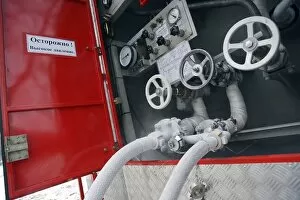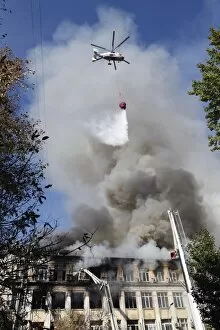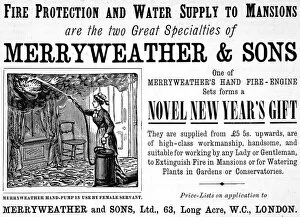Extinguishing Collection (#4)
"From rejected ideas to life-saving innovations: the journey of extinguishing" In the 19th century, fire sprinklers emerged as a promising solution for combating flames
For sale as Licensed Images
Choose your image, Select your licence and Download the media
"From rejected ideas to life-saving innovations: the journey of extinguishing" In the 19th century, fire sprinklers emerged as a promising solution for combating flames. However, they were initially rejected by the inventions board, underestimating their potential. The advent of the first petrol fire-engine revolutionized firefighting techniques. This groundbreaking invention provided firefighters with a powerful tool to battle blazes more effectively. Amidst turbulent times, G. H. Davis introduced a new German incendiary bomb that posed immense threats during wartime. Its destructive power demanded innovative ways to extinguish its fiery havoc. One such incident occurred at Sir C. Prices Wharf in Blackfriars in 1845, where an unknown creator fought valiantly against a conflagration using primitive means. Their bravery highlighted the need for advanced fire suppression systems. Firefighters underwent rigorous training at Lambeth HQ to enhance their skills and readiness when facing dangerous infernos head-on. Their dedication ensured public safety and inspired others to develop labor-saving devices like those envisioned by William Heath Robinson. During World War II's Blitz in London, ingenious couples devised makeshift pumps from their bedsides to extinguish incendiary bombs landing in their homes without disturbing their sleeping baby—a testament to human resilience amidst chaos. John Lewis on Oxford Street became an unfortunate victim of fires during this tumultuous period but demonstrated unwavering determination and resilience amid destruction. Meanwhile, across the Atlantic Ocean in Texas, capping burning oil wells became an urgent challenge requiring specialized expertise and innovative methods—highlighting humanity's ability to overcome even nature's fury through collective efforts. Even theaters faced perilous fires that threatened lives; Professor Pepper's demonstrations at Sadler's Wells Theatre showcased both danger and innovation as audiences witnessed firefighting techniques firsthand—an unforgettable experience etched into history books forever. Through rejection or adversity, each chapter reveals our relentless pursuit of safer communities—where extinguishing flames becomes a shared responsibility, and the spirit of innovation continues to shine brightly.








